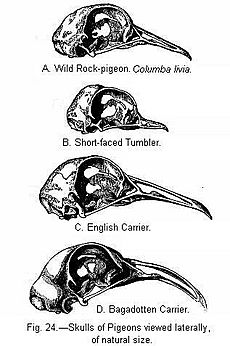English Carrier pigeon facts for kids

A blue bar English Carrier
|
|
| Conservation status | Common |
|---|---|
| Other names | English Carrier |
| Country of origin | England |
| Classification | |
| US Breed Group | Wattle |
| EE Breed Group | Wattle |
| Notes | |
| One of the oldest fancy breeds. | |
|
|
The Carrier or English Carrier is a special type of pigeon. People have carefully bred these pigeons for many years to get their unique look. This process is called selective breeding. Like all domesticated pigeons, Carriers came from the wild rock dove. They have a long, thin body and a long neck. They also have a special rounded, hard growth on their face called a wattle.
Contents
The History of Carrier Pigeons
How the Breed Developed
The Carrier pigeon breed started in England. It was created by mixing different pigeon types from other countries. These included the Persian and Baghdad carriers, and also the pouter pigeon. The Old English Carrier was once the largest flying pigeon breed. It was first used to send messages over long distances.
From Messengers to Show Birds
By the mid-1800s, the English Carrier was considered a perfect breed. People admired its unique features. At that time, these pigeons mostly came in black, white, or a brownish-grey color called dun.
Today, the English Carrier is no longer used for sending messages. It is now a show pigeon, bred for its looks. The modern pigeon used for racing messages is called a Racing Homer. This breed was developed from eight different pigeon types, including the English Carrier.
What Does a Carrier Pigeon Look Like?
Size and Shape
The famous scientist Charles Darwin wrote about the Carrier pigeon. He described it as a "fine bird" that is large and has smooth feathers. He also noted its long neck. Darwin compared the Carrier's size to the wild rock dove. He found that the Carrier was almost twice as long. It could also open its mouth wider, about 0.75 inches (1.9 cm) compared to the rock dove's 0.4 inches (1.0 cm).
An English Carrier pigeon is usually about 17.5–18.5 inches (44–47 cm) tall. It has a long, slender body. Its breast bone should be straight and long. The back should also be long and slope down towards its tail. The neck looks long compared to the rest of the bird. Its legs are strong and do not have feathers below the knees.
Unique Features: Eyes, Wattle, and Beak
English Carriers typically have deep red eyes. They also have a very noticeable wattle. This wattle is a large, firm, and rounded growth on their face. It usually has a powdery white surface.
Their beak is long and thick, known as a "box beak." The National English Carrier Club has specific standards for the breed. For example, the distance from the eye to the tip of the beak should be at least 2 inches (5.1 cm) for female pigeons. For males, it should be at least 2.5 inches (6.4 cm).


